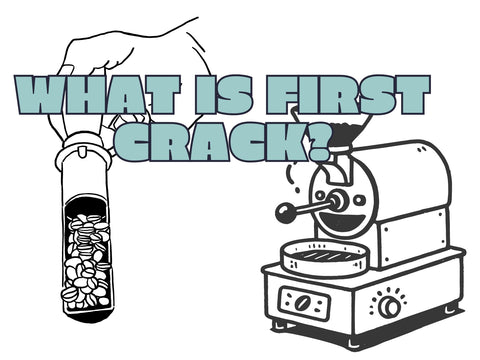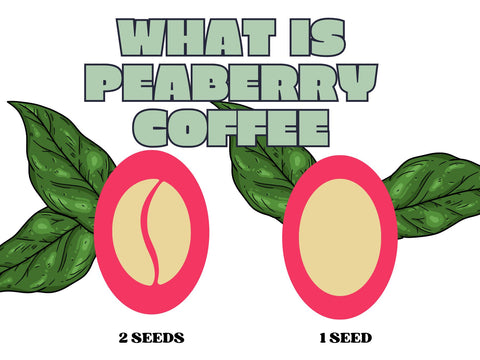The coffee roasting process can make an immense difference in the flavor and quality of the final product. One important aspect of coffee roasting is the first crack.
This is a key stage in the coffee roasting process and essential for developing the coffee beans' flavor. Roasters can control the development of flavor by understanding this stage.
By observing the bean temperature, listening to the popping sound, and watching the coffee beans change color, roasters can determine when first crack has occurred and choose to continue roasting the beans to a darker roast or to stop the roast at this point.
So, let's look at what this important step for roasted coffee is and how roasters can use that knowledge to create delicious and satisfying coffees.
What Is First Crack?
First crack happens when the coffee beans begin to release moisture and carbon dioxide, and the internal temperature reaches around 196°C (385°F). Roasters listen for a loud cracking sound to determine when the coffee roasting process has arrived at this chemical reaction.
Before this, the green coffee beans absorbed heat energy and underwent various chemical reactions. After first crack, the beans release energy and undergo significant changes in flavor and aroma. You can almost compare the sound to popcorn popping.
The coffee roaster has to decide how long to continue roasting after this stage: The longer a bean is roasted in an air roaster or other roasting machine after this stage, the darker and intenser the coffee's flavor will be.
When Should First Crack Happen?
First crack should happen at around 196°C during the roasting process of green coffee. This is the stage when a green bean undergoes an exothermic reaction. At this point, the beans spontaneously expand and expel chaff, they start to give off smoke, and a good roaster knows how to recognize the audible crack.
Flavour Development
When roasting coffee, most roasters focus on first and second crack. However, the real goal of a good roaster is to achieve a wonderful flavor profile. This means considering caramelization and the Maillard reaction, which occur before first crack.
Among all the exothermic reactions, the Maillard reaction is especially important for many of the flavors in coffee. This reaction takes place when amino acids and sugars react together in the presence of heat. This reaction starts at around 150 degrees Celsius.
Caramelization, which you may know from cooking, is a different process during coffee roasting. This process gives coffee a pleasant caramel or toffee flavor. Caramelization starts at around 170 degrees Celsius.
Since it is difficult to predict the exact timing of these reactions, paying attention to the aroma and color of the beans during the roasting process is important.
How Long Should First Crack Last?
The length of this stage depends on several factors, like the type of coffee beans and the roasting technique. However, it will generally last about 1-3 minutes.
For a light roast, it should be relatively short, lasting only about 1 minute. This is because light roasts are roasted to a lower temperature, which slows down the Maillard reaction and caramelization.
For a medium roast, it should last for about 2 minutes. This is a good range for medium roasts, as it allows the Maillard reaction and caramelization to develop somewhat, but not too much.
For a dark roast, it should last for about 3 minutes. This is because dark roasts are roasted to a higher temperature, which speeds up the Maillard reaction and caramelization.
What Is Second Crack?
Second is similar to first crack but not always part of the roasting process, especially when it comes to lighter roasts. Second crack occurs at 224-240°C (435-464°F). It is a sign that the coffee beans are close to the end of the roasting process.
The time between first and second crack varies depending on the type of coffee beans, bean size, the heat source, and the roasting technique. However, it is generally a good idea to stop roasting the beans shortly after second crack, as roasting them for too long can produce a bitter or burnt flavor.
Always keep an eye on the roast colour, too.
Is Second Crack Louder Than First Crack?
Like first crack, second crack can be compared to popcorn popping, but it is usually not louder. This is because the coffee bean is more brittle when the roasting process arrives at second crack.
The carbon monoxide can escape more easily, leading to a softer cracking sound. The first cracking is louder because the steam has to crack open the bean's shell.
When Should You Stop Roasting Coffee?
How long you should roast a coffee bean depends greatly on your goal. If you're after creating a specialty coffee with a beautiful flavor profile, you need to know how to achieve this.
If you're after a light specialty coffee, you must stop after first crack to get a light brown bean with no oil on its surface. These roasts are the best choice if you want to conserve a coffee bean's distinct origin flavor and are perfect for a nice morning cup.
If you're after darker roasts, on the other hand, you wait until after second crack to get a shiny black coffee bean with an oily surface. These are pretty bitter coffees, and you won't notice much of the bean's origin flavors.
For anything in between, i.e., medium and medium-dark roasts, a good roaster must judge a coffee bean's color and be aware of the bean's scent. It's a fine balance, and how long you need to roast a coffee also depends on the equipment available to you.
Why First Crack Is Important?
Understanding first crack is important in coffee roasting because it marks an important stage of the coffee roasting process. This stage tells coffee roasters that a once green bean has reached its light to medium roast level. It's the magical moment when a coffee bean's personality starts to shine! Roasters carefully monitor first crack to create the perfect cup with the right balance of acidity, sweetness, and complexity. So next time you enjoy the smell and taste of your morning brew, remember that first crack is the main driver for the great flavor in your cup.


